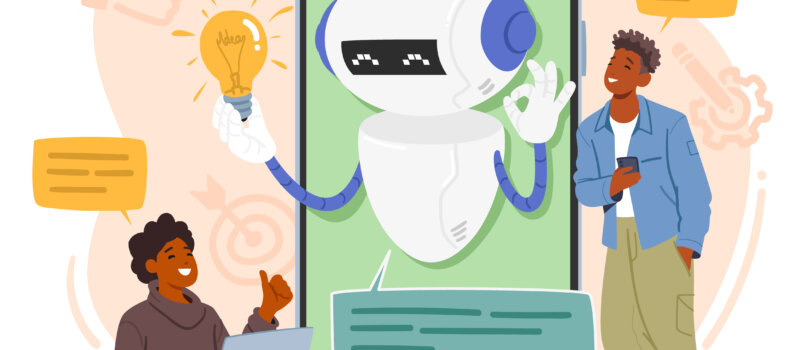Creating great customer experiences is critical to retention and building loyalty. If your customers don’t receive great service, it increases the likelihood they’ll take their business elsewhere. Problems often lie in the workflows, processes, and technology that a company uses. When not optimized, long wait times, customers ending up with the wrong agents, and other inefficiencies can occur. To empower your contact center team, you can improve these with customer service automation.
In this post, we’ll review what automation is and the essential tasks ideal for applying it.
What Is Customer Service Automation?
Customer service automation describes the use of workflows and technology to remove manual effort. There are many aspects of the customer service ecosystem that don’t need human intervention. When you automate, you streamline processes and eliminate repetitive tasks from your staff’s purview. As such, they can help you use your people more resourcefully, reduce costs, and enhance customer experiences.
How Does Automation for Customer Service Benefit Your Business?
Automation, in any aspect, is about accelerating processes and reducing manual efforts. When you do this in customer service, you can reap these benefits.
Reduced Costs
Contact centers are a cost center. The highest cost is the labor itself, so you want to ensure that your staff focuses on customer interactions, not administrative work. According to McKinsey, automation technology can reduce costs by up to 40 percent. Those savings result from not needing to increase headcount because automation picks up the pace and quicker resolutions so agents can be more productive.
Happier Agents
If your team is no longer in the trenches of manual work, they’ll be not only more productive but also often more satisfied. Turnover in contact centers can be high. If you provide your people with great tech and efficient processes, they’ll be more engaged.
Better Customer Experiences
With automation in place, obtaining service is more convenient for customers. They won’t have to go through outdated processes to get some answers. When you can meet customers where they are and quickly provide them with accurate information, they’ll appreciate it.

Key Tasks to Automate in the Customer Service Journey
Next, let’s outline the specific tasks where you can use automation to help you realize the benefits mentioned above. These automation capabilities are often part of contact center software.
Call Routing with IVR
IVR (interactive voice response) is essential to automating call routing. The system interacts with callers, gathering information about their call. In some cases, they may not need agent support. So IVR becomes a self-service hub for customers to get information like a company address or take an action like paying a bill or checking a balance.
If the customer needs agent support, IVR sends the caller to the appropriate team. IVR systems are notorious for being hard to update or change, so be sure your software has an easy solution.
Omnichannel Integration and Smart Routing
The next task perfect for automation is integrating and routing all your channels. Customers want options on how to get help — voice, email, chat, social media, etc. If all these channels exist individually, it’s too much to manage manually.
You can integrate all channels into one queue using automation technology, and agents can take them as they come in regardless of the medium. It streamlines the customer experience and provides insights into the volume of inquiries, the duration of interactions, and what channels your customers prefer.
The other component of omnichannel communication is smart routing, discussed earlier in the IVR section. The same capabilities are available for all your channels.
Chatbots for Self-Service and Always-On Support
Chat is a popular option for customer service. Most consumers are familiar with it and don’t mind using it to find quick answers. While humans can be part of your webchat, they don’t always need to be.
If a customer has a simple, straightforward question, a chatbot can respond and point that person to an FAQ or knowledge base to find the answer.
An automated chatbot can also be useful to enable 24-hour service. If the query requires agent support, the chatbot advises the customer of this. Then it informs them that their ticket will be in the queue as soon as your customer service team is back online.
Outbound Outreach with Dynamic Notifications
Your customer service center may also be responsible for outbound outreach to customers. Those communications could include things like appointment reminders, alerts for package shipments, important updates, or scheduling.
You can automate that through your contact center software using voice, SMS, or email. That reduces the manual work of an agent making contact for each customer. These notifications also keep customers informed and reminded.
Reporting and Analytics
Your contact center is a treasure trove of data. In addition to agent and queue performance, there’s so much you can learn from these interactions. That’s why reporting and analytics are crucial, but you shouldn’t have to run these manually, taking hours out of your day. Instead, your platform should have standard and custom report options that automatically run at your preferred interval.
Customer Service Automation: Optimize Processes to Save Time, Money, and Resources
These customer service automation opportunities are great for your company, agents, and customers. Implementing these ensures optimized processes, saving you time, money, and resources.
Find out how we deliver these features and more by requesting a demo of Intermedia Contact Center.
June 7, 2022
Explore other posts on these topics: Contact Center




